Poland 2020 "Dinosaurs"
| <prev | back to index | next> |
| Issue Date | 25.11.2020 |
| ID | Michel: Scott: 4520a-c UPU: Category: pR |
| Design | Andrzej Gosik Consultant Dr. Gerard Gierliński from the Polish Geological Institute |
| Stamps in set | 3 |
| Value |
Pzl 3,30 Dilophosaurus Pzl 3,30 Scelidosaurus Pzl 3,30 Coelophysis |
| Emission/Type | commemorative |
| Places of issue | Warsaw |
| Size (width x height) | 76.5 mm x 31.25 mm |
| Layout | Mini-Sheet of 2 sets (6 stamps in total) |
| Products | FDC x 3, Mini-Sheet |
| Paper | white medium smooth fluorescent |
| Perforation | 12 x 11.5 |
| Print Technique | Offset |
| Printed by | Polska Wytwrnia Papierw Wartosciowych (PWPW) |
| Quantity | 90.000 sets |
| Issuing Authority | Polish Post |
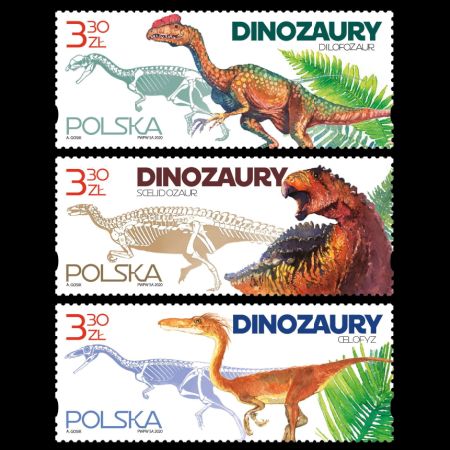
On November 25th, 2020, the Polish Postal Authority issued the set of 3 "Dinosaurs" stamps.
These stamps show skeletons and reconstruction of a large predatory dinosaur
Dilophosaurus,
a large herbivorous dinosaur Scelidosaurus
and a small predatory dinosaur Coelophysis.
These stamps are based on illustrations made by Polish artist Andrzej Gosik who painted his sketches
with his favorite watercolor technique.
Mr. Gosik designed many stamps for Polish Post (Poczta Polska) in the past, but it was the first time
he painted some prehistoric animals.
"One of the essential elements of the mission of Poczta Polska is education.
We have been trying to fulfill this need for years through our philatelic publications - stamps, cards, date stamps.
We show historical events of outstanding Poles, we present cultural and religious heritage, but also topics related
to technology, science and nature.
A fantastic example of this type of philatelic value are three postage stamps dedicated to dinosaurs.
Not everyone is aware of the fact that these prehistoric reptiles also occurred in Poland.
By creating this issue, we learned interesting details about the research conducted in Poland.
We collaborated with an expert on this topic, Dr. Gerard Gierliński from the Polish Geological Institute.
He is a world-renowned researcher and discoverer of dinosaur footprints in Poland, as well as the author
of books and publications in prestigious palaeontological journals.
The designs of the stamps were based on the studies and sketches of Dr. Gierliński.
I hope that the stamps introduced into circulation will also encourage our customers to learn more about
reptiles from over 200 million years ago"
- said Wiesław Włodek, vice president of the management board of Poczta Polska.
According to Dr. Gierliński, Poczta Polska had the previous idea to show three Late Triassic
vertebrates found in Silesia as ancient Polish animals on their "Dinosaur" stamps.
Following his explanation that Silesaurus, Smok and Lisowicia are not dinosaurs
(Silesaurus and Smok are archosaurs, Lisowicia is a giant dicynodont synapsid)
he proposed that they make a set of stamps focusing on the dinosaur footprints from the Early Jurassic of the Holy Cross Mountains,
such as Grallator, Moyenisauropus and Kayentapus.
Grallator, Moyenisauropus and Kayentapus are not dinosaur species names,
but the footprint names, called ichnogenera in Paleontology.
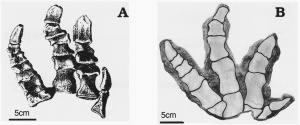
|
|
A. Footprint of Scelidosaurus harrisonii described by Sir Richard Owen in 1861 B. Footprint of Moyenisauropus karaszevskii described by Dr. Gerard Gierliliski in 1991 from the late Hettangian of Gliniany Las in Poland. |
| The image above is from " Tracks of a large thyreophoran dinosaur from the Early Jurassic of Poland" by Dr. Gerard Gierliliski, published in Acta Paleontologica Polonica in 1999. |
Due to this reason the Polish Post decided to show some dinosaurs who are probably the trackmakers of these footprints, even though their fossils not found in Poland to date:
- Coelophysis as possible trackmaker of Grallator
- Dilophosaurus as possible trackmaker of Kayentapus
- Scelidosaurus as possible trackmaker of Moyenisauropus
The assumption about potential trackmakers was done based on comparison with footprints of well-known dinosaurs, as shown on the example on the right side. Interesting fact: some of Moyenisauropus footprints were discovered near ancient petroglyphs (northern slope of the Holy Cross Mountains by the Polish village of Kontrewers).
Perhaps the dinosaur footprint was a part of occult gatherings there. This combination of dinosaur footprint and the ancient rock art is unique in Europe.
It is pity that none of the footprints were shown on these post stamp or First Day Covers.
Only the skull on the postmark that used on FDC covers belongs to the "native" Polish prehistoric animals, the early archosaurian reptile (a dinosauriform) from the Late Triassic - Silesaurus who is well known from many fossils discovered in Poland.
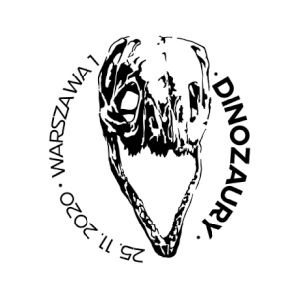
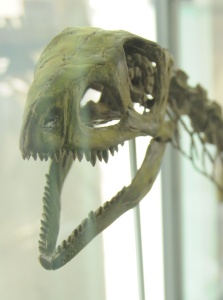 Skull of Silesaurus depicted on the postmark of FDC covers.
Skull of Silesaurus depicted on the postmark of FDC covers.Silesaurus is a dinosauriform genus of early archosaurian reptile from the Late Triassic, approximately 230 million years ago in the Carnian Stage of what is now Poland.
Archosaurs are a group of diapsid reptiles represented by modern birds and crocodilians. This group also includes extinct non-avian dinosaurs, pterosaurs and relatives of crocodiles.
Fossilized remains of Silesaurus have been found in the Keuper Claystone of Opole, Silesia, Poland, which is also the origin of its name. The type species, Silesaurus opolensis, was described by Jerzy Dzik in 2003. It is known from some 20 skeletons, making it one of the best-represented of the early dinosaurs and related animals.The animal was approximately 2.3 meters in length and 1 meter tall at the hip. Lightly built, it was probably a fast and agile animal with an active lifestyle. Current research, based on analysis of its coprolites, suggest that Silesaurus fed on insects and other small arthropods.
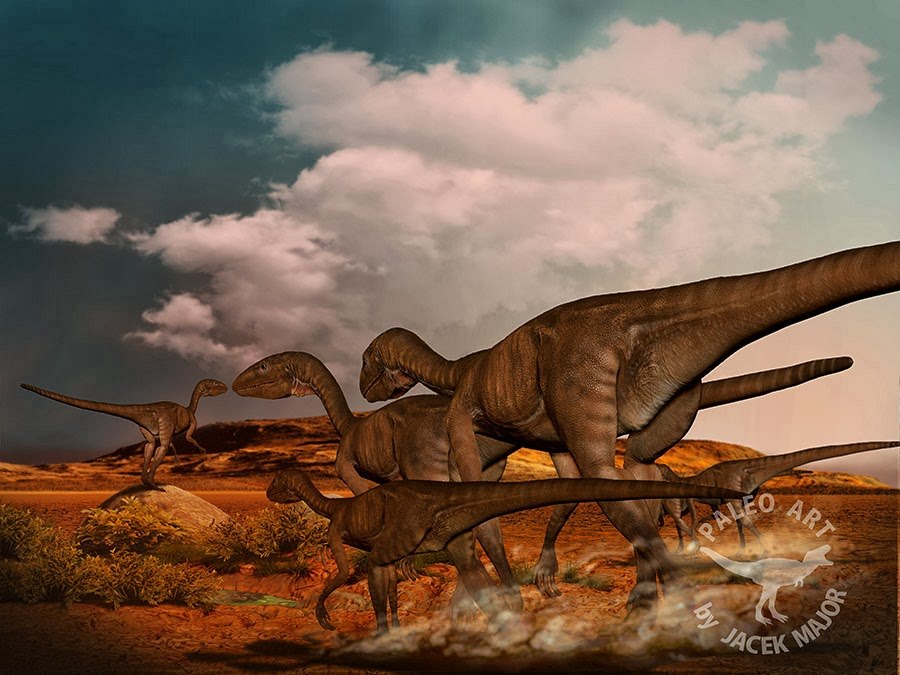
Reconstruction of Silesaurus opolensis by Polish paleo-artist Jacek Major.
Another two prehistoric animals that were supposed to appear on Polish stamps are Smok and Lisowicia.
Smok is an extinct genus of
large carnivorous archosaur,
who lived during the latest Triassic period, about 205–200 million year ago.
Its remains have been found in Lisowice, southern Poland.
The type species Smok wawelski was named in 2012.
When the discovery was first announced, it was called "the Dragon of Lisowice",
after the mythological Polish dragon of the same name that lived in a cave (Wawel Hill) near the excavation site.
The exact classification remains difficult because Smok displays features of
saurischian dinosaur, a rauisuchian, and even an ornithosuchid crurotarsan, therefore
it was classified as an archosaur.
At an estimated 5 to 6 metersin length, Smok was the largest carnivorous archosaur in central Europe at the time.
Study of coprolites done by Swedish paleontologists from Uppsala University
concluded that this top predator, who probably is the first member of a line of
dinosaurs that led to Tyrannosaurus rex, had very strong bite and was exploiting bones for salt and marrow.
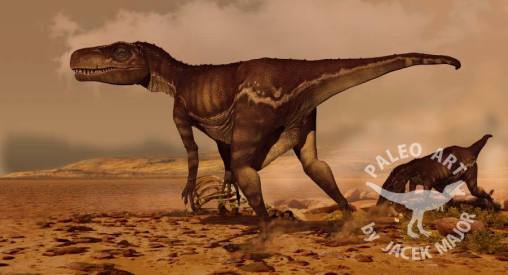
|
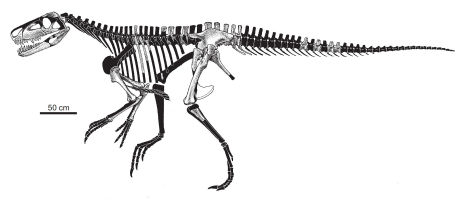
|
|
Reconstruction of Smok by Polish paleo-artist Jacek Major. The image is from deviantart.com |
Skeleton reconstruction of Smok, based on its partial fossil. The image is from Wikipedia |
Lisowicia is unique among dicynodonts for its erect posture with all four limbs held upright directly under its body.
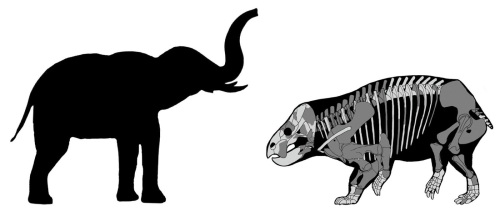 |
|
Size comparison of Lisowicia bojani versus modern elephant. Light gray bones of Lisowicia's skeleton represent missing elements. The image is from dw.com |
The animal, with a body like a giant rhinoceros, was equipped with a turtle-like beak for munching plants, estimated to have weighed between 5–6 tons, a hip height of over 2 meters and its body length was estimated to be around 4.5 meters long.
Researchers discovered the fossilized bones of the four-legged creature, at the village of Lisowice in southern Poland in 2008, but it took another decade to study and describe it. The dicynodont was named in 2018 and described in 2019 by Polish paleontologists Tomasz Sulej and Grzegorz Niedźwiedzki.
To date (2020), there is only one species: Lisowicia bojani of the animal and it is known from only one place.
Lisowicia, named after the village where the bones were found; bojani, named in honor of comparative anatomist and paleontologist Ludwig Heinrich Bojanus (1776–1827).
Some bones, vertebrae and footprints of many other prehistoric animals are found at the same place with Lisowicia fossils. This indicates that the animal coexisted with a broad variety of Late Triassic animals such as archosaurs, including a Coelophysis-like theropod.
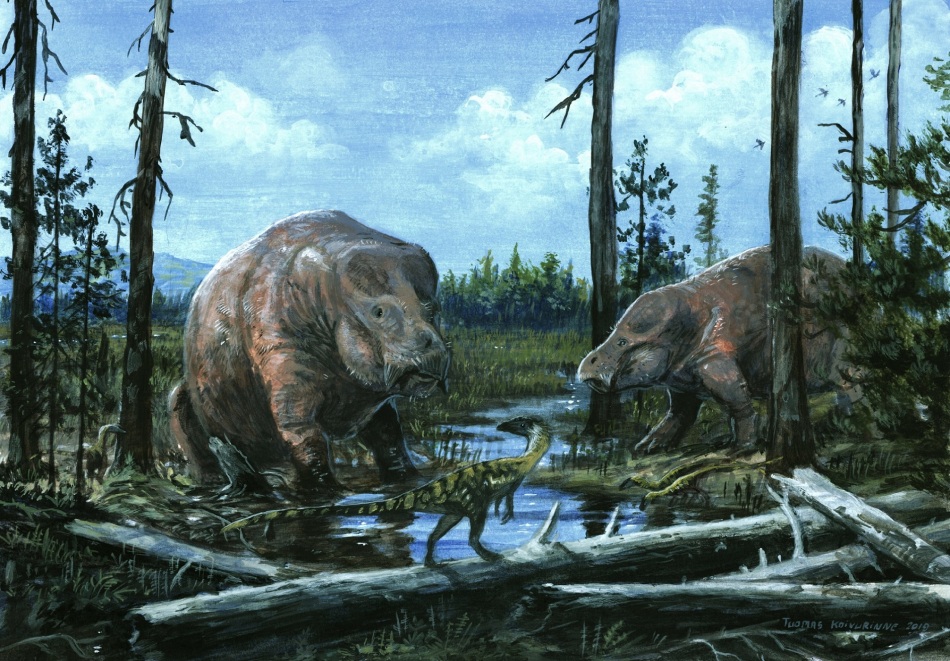
Coelophysis (CELOFYZ on the stamp)
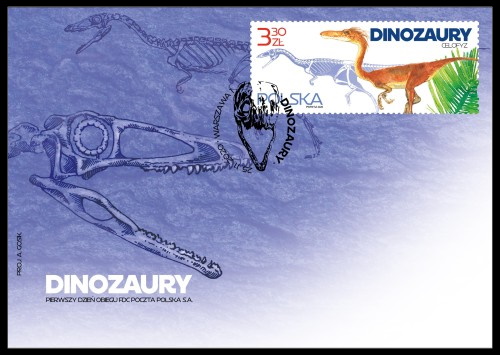
Coelophysis is A theropod dinosaur that lived approximately 216 to 196 million years ago
in what is now the southwestern United States and also
in South Africa and Zimbabwe.
Coelophysis, was a fast and agile runner, lightly built, about 3 meters long,
and weighing up to 20 kilograms, this predator likely fed on other small reptiles including the early relatives of mammals.
It may also have hunted in packs to tackle larger prey.
The dinosaur had narrow hips, forelimbs adapted for grasping prey, and narrow feet.
Coelophysis also preserves the ancestral condition of possessing four digits on the hand (manus).
It had only three functional digits, the fourth embedded in the flesh of the hand.
Coelophysis had large, forward-facing eyes that afforded it stereoscopic vision and as a result excellent depth perception,
his eyes appear to be similar to those of modern eagles and Hawks, with a higher power of accommodation.
Accommodation is the ability for animal to keep an object in focus even though the distance to the object is changing.
The data also suggested poor night vision.
The name Coelophysis means "hollow form" which is a reference to its hollow vertebrae.
It is one of the earliest known dinosaur genera, described by the famous American paleontologist Edward Drinker Cope
in 1887 based on some poorly preserved fossils.
Much later, in 1947, hundreds of skeletons of the dinosaur found at Ghost Ranch, near Abuquiu, New Mexico.
Some were very well preserved and fully articulated, and one of these individuals eventually replaced the original,
poorly preserved type specimen for the species.
Use full screen option for more convenient view.
Fossils (single bones and vertebrae) and footprints of dinosaur that resembles those of young Coelophysis from Ghost Ranch Quarries discovered at the Drzewica Formation and near village Lisowice in southern Poland .
Dilophosaurus (DILOFOZAUR on the stamp)
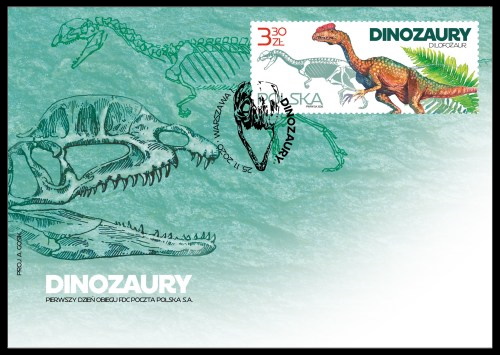
Dilophosaurus is a genus of theropod dinosaur that lived during the Early Jurassic, about 193 million years ago.
Three skeletons were discovered in northern Arizona (USA) in 1940,
and the two best preserved were collected in 1942.
Some footprints of the dinosaurs were also found in Europe - in the Holy Cross Mountains in Poland
and in the Höganäs Formation in Sweden.
Both traces were assigned to Dilophosaurus by Polish paleontologist Dr. Gerard Gierliński who studied them in 1991 and 1994 accordingly.
Dilophosaurus was a slender and lightly built dinosaur,
with a proportionally large, but delicate skull (shown on the cachet of FDC).
The snout was narrow, when the upper jaw had a gap or kink below the nostril (see on the FDC).
It had a pair of longitudinal, arched crests on its skull; their complete shape is unknown, but they were
probably enlarged by keratin.
The function of the crests is unknown; they were too weak for battle, but may have been used in visual display, such as species recognition and sexual selection.
The teeth were long, curved, thin, and compressed sideways.
Those in the lower jaw were much smaller than those of the upper jaw.
The neck was long with hollow vertebrae, and therefore very light.
The arms were powerful, with a long and slender upper arm bone.
At about 7 meters in length, with a weight of about 400 kg Dilophosaurus was one of the earliest large
predatory dinosaurs and the largest known land-animal in North America at the time.
Dilophosaurus may have hunted large animals as well as smaller animals and fish.
Use full screen option for more convenient view.
Scelidosaurus (SCELIDOZAUR on the stamp)
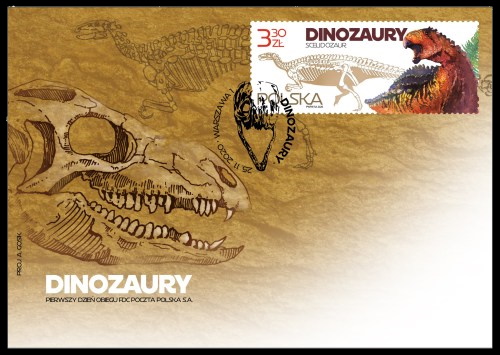
Scelidosaurus with the intended meaning of "limb lizard"
(from Greek skelis meaning 'rib of beef' and sauros meaning 'lizard'),
is a genus of herbivorous armored ornithischian dinosaur
from the Jurassic of England, who lived around 191 million years ago.
Its fossils have been found near Charmouth in Dorset, England, and are known for their excellent preservation.
The dinosaur was described by legendary paleontologist Sir Richard Owen in 1859.
Scelidosaurus has been called the earliest complete dinosaur and it is the most completely known dinosaur
of the British Isles.
By the way, Scelidosaurus is currently one of the two known dinosaur genera known from fossils in Ireland.
Two single bones that belongs to two different dinosaurs were found on the island, as reported by paleontologists
from the Ulster Museum in Belfast in November 2020
and published in major Irish newspapers between November 24 and November 26, just at the time of the release of these Polish stamps.
Scelidosaurus was a large quadrupedal dinosaur about 4 meters long and weighing 270 kilograms.
The animal was protected by long horizontal rows of keeled oval scutes that stretched along the neck, back and tail.
Its skull had horns on its back edge, unfortunately this detail was not used in the reconstruction shown on the Polish stamp.
Some studies suggest that the dinosaur fed on low scrubby vegetation, with a height up to one meter.
It may have been a coastal animal, perhaps even eating seaweed like marine iguanas do today.
Raising itself on its hindlimbs alone, could have vertically increased the feeding envelope and was perhaps anatomically possible.
Scelidosaurus had been seen for many decades as an early member of the group that included the Stegosaurs and Ankylosaurs,
but that was based on a poor understanding of its anatomy.
Now it seems that the dinosaur is an ancestor of the Ankylosaurs (the armor-plated ‘tanks’ of the Late Cretaceous Period) only,
says Dr. David Norman from the University of Cambridge's Department of Earth Sciences who has devoted much of his time,
between 2017 and 2020, to preparing a detailed description and biological analysis of Scelidosaurus.
Dr. Norman published several articles in the Zoological Journal of the Linnean Society in 2019 and 2020
on the relationship between Scelidosaurus and the Thyreophora
(a taxon that includes the suborders Stegosauria and Ankylosauria).
A trackway from the Holy Cross Mountains of Poland shows a Scelidosaurus-like animal walking in a bipedal manner,
indicating that the animal may have been more proficient at bipedalism than previously thought.
Use full screen option for more convenient view.
Products and associated philatelic items
| Mini-Sheet | FDC | First-Day-of-Issue Postmark |
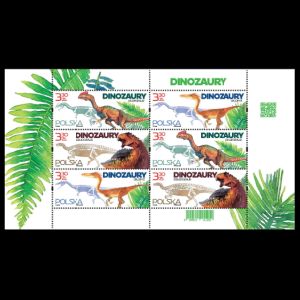 |
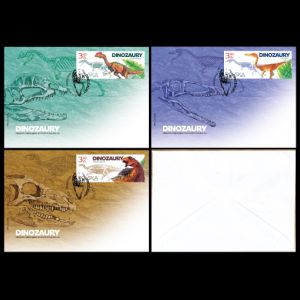 |
 |
| Example of circulated cover | Circulated FDC | |
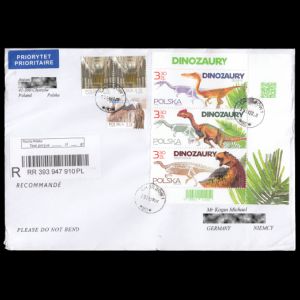 |
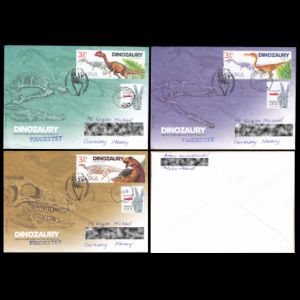 |
|

|
References
- Technical details and short description:
Poczta Polska, nowinkiolesnickie.pl (the article does not exist anymore) infowire.pl. - Dilophosaurus: Wikipedia.
- Scelidosaurus: Wikipedia, SCI News, Natural History Museum in London, University of Cambridge, Zoological Journal of the Linnean Society.
- Coelophysis: Encyclopaedia Britannica, Wikipedia.
- Dinosaur bones discovery in Ireland: SCI News from November 24the 2020, Irish Post from November 25the 2020 (the day the Polish stamps were issued), CNN from November 26the 2020.
- Lisowicia:
Wikipedia,
DW.com,
slashgear.com,
" A dicynodont−theropod association in the latest Triassic of Poland" by JERZY DZIK, TOMASZ SULEJ, and GRZEGORZ NIEDŹWIEDZK
" An elephant-sized Late Triassic synapsid with erect limbs" by TOMASZ SULEJ, and GRZEGORZ NIEDŹWIEDZKI. - Silesaurus: Wikipedia, fossil.fandom.com.
- Smok: Wikipedia, phys.org, prehistoric-wildlife.com.
- Moyenisauropus: " Tracks of a large thyreophoran dinosaur from the Early Jurassic of Poland" by Dr. Gerard Gierliliski.
- Drzewica Formation: Wikipedia
Acknowledgements
Many thanks to
- Dr. Peter Voice from Department of Geological and Environmental Sciences, Western Michigan University, for reviewing the draft page and his very valuable comments.
- Dr. Gerard Gierliński from the Polish Geological Institute, for his valuable comments and explanations.
- Julius Csotony, famous Canadian paleoartist and natural history illustrator, who also designed some dinosaur stamps for Canada and USA, for his help finding some information about prehistoric animals mentioned in this article.
| <prev | back to index | next> |